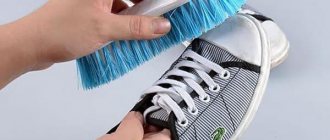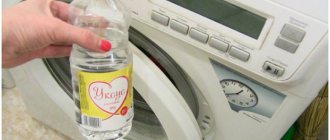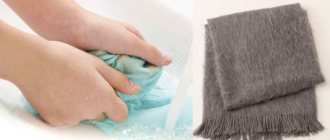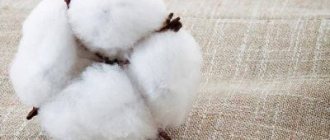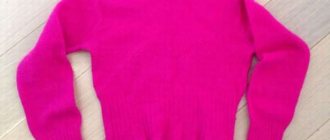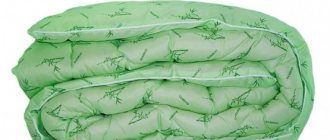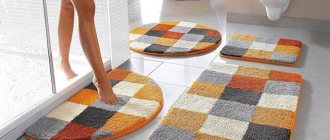A tie is an attribute of a male, and sometimes female, business look.
Depending on the design, it can serve as an original addition even to a fashionable youth informal look. To maintain the neat, presentable appearance of this accessory, you should know how to properly care for it: wash, dry, iron and store.
So, is it possible and how to properly wash a men’s tie at home?
Can it be washed?
Before you start washing your tie, you need to find the label for the item and find out what kind of exposure it can be exposed to .
Based on the information provided by the manufacturer himself, the possibility and conditions of washing are determined.
Some ties cannot be washed at all and must be dry cleaned. These exceptions include some models with complex designs or made from very delicate fabrics.
But most can be cleaned and refreshed at home without any problems . The main thing is to take into account the characteristics of the material. For example, natural silk is washed only by hand in a weak soap solution.
Regardless of the material of manufacture, aggressive agents and intense friction are not used to clean ties. But stain removers designed for the care of delicate fabrics can be used. If there are stains on the fabric, you should try to remove them before washing the item.
Before processing, it is recommended to check the durability of the paint. To do this, lightly rub the material from the inside out with a damp white cloth. If the fabric is stained, then you can wash such a tie only by hand, using minimal water and reducing the processing time.
The care instructions given by the manufacturer should not be violated. Based on the information on the tag, you can determine what kind of care the item requires. The symbols have the following meaning:
Preparation
Many housewives have faced the problem of spoilage. This may be due to improper preparation.
To avoid trouble, carefully read the instructions that manufacturers place on the label.
The degree of contamination plays an important role. If a stain is planted, it is necessary to carry out measures to remove it. Many models can be made from not very high-quality fabric.
Subsequently, such decoration may fade.
To check this, you need to take a damp cloth and wipe a small area of the accessory, preferably from the wrong side if the fabric is the same on both sides.
If there is any color left on the napkin, this is a sign that it is fading, which means it is best to wash it by hand.
If there is no dye on the napkin, then the tie can be washed either by machine or by hand.
It is important to choose the right product to get rid of dirt. Don't buy powder. It is best when the detergent has a liquid or gel-like consistency.
Be sure to pay attention to the range of canvases that can be treated with this substance.
To prevent this item of men's wardrobe from losing its shape, it is best to purchase a special plastic template that is inserted inside.
You can make it yourself from cardboard and wrap it with tape.
How to machine wash?
Machine wash simplifies the process of caring for things . But this method is not suitable for all ties.
If there is no prohibition on machine processing, you must act taking into account all the requirements for caring for the item. The choice of detergent, temperature and mode setting requires special attention.
Which product should I choose?
A tie is a delicate item. To wash it, it is recommended to use liquid detergents in gel form. They dissolve better and are distributed more evenly in water when compared with powders.
Poorly dissolved detergent can ruin the item due to the granules it contains.
Temperature and mode
The choice of washing mode determines the degree of intensity and duration of exposure. “Delicate” is optimal.
In this case, some processing parameters will need to be adjusted:
- spin – turn off;
- set the temperature to no higher than +40°C (in accordance with the manufacturer’s recommendations on the product label);
- The duration of washing is no more than an hour.
The delicate material of the tie may be damaged if it comes into contact with the drum of the washing machine and other things. To prevent this, it is recommended to use a laundry bag for delicate items or a special container.
Care
In order for a tie to retain its attractive appearance longer and not lose its shape, it must be properly cared for. In the evening, the accessory must be unraveled and hung on a hanger specially designed for this purpose.
This device has a special coating that prevents the tie from slipping and allows you to maintain an attractive appearance longer. In order for the product to straighten and take its original shape, it is hung in the closet at a distance from other things.
An easier way to store men's ties is to roll them up and store them on a shelf separately from other things. To reduce wrinkles in your tie, do not make the knot too tight when tightening it. This simplifies maintenance and preserves the structure of the material.
Manual processing
Hand washing allows you to wash your tie very carefully, paying attention to the stained areas. For this:
Warm water (up to +40°C) is poured into the prepared container.- Dilute the detergent.
- After foam appears, carefully lower the tie into the basin.
- Leave for 15-30 minutes.
- Using a soft sponge, smooth the tie along the tie at an angle.
- Rinse, changing the water. If you are not sure about the composition of the material, then you should rinse the product several times, gradually lowering the temperature.
During the washing and rinsing process, all movements should be directed only diagonally to avoid twisting of the material and deformation of the shape.
How to wash a tie by hand
Washing ties by hand is preferable - only in this case you are guaranteed not to spoil the delicate item.
Required:
- basin;
- warm water;
- cleanser;
- soft sponge.
Procedure:
- Completely dissolve the detergent in water.
- Immerse the tie in the bath and leave to soak for half an hour.
- Take out the accessory and spread it on the table.
- Using a sponge, wipe the material with gentle movements (diagonally). If you move along the tie, it will probably lose its shape.
- Rinse the product in the basin, changing the water several times.
Important: never wring out the tie, much less twist it.
Silk items must be rinsed properly. Use warm water first, and then keep it only slightly cooler. Sudden temperature changes are harmful to delicate fabrics.
Bright ties retain their color better if you add about 0.5 tsp to the bowl during the last rinse. salt. Be sure to wait until the crystals are completely dissolved.
Choice of product
The selection of the product is a very important point. In the vast majority of cases, compositions containing chlorine are not suitable for ties - this is indicated by the picture on the label (crossed out triangle).
Please note that washing powder is not suitable for silk accessories. It does not always completely dissolve in water, and remaining granules can damage the material. For this reason, before washing your tie at home, make sure you have a good liquid gel on hand, designed specifically for delicate textiles. Acceptable use:
- Wellery - this gel does not reduce the brightness of the product’s shade and preserves the structure of any fabric. It is expensive, but it is also used economically.
- Power Wash is another excellent product, however, according to reviews, it does not always cope with old stains.
- Persil Gel is an ideal option for a tie, as it helps smooth out the fibers of the material and perfectly removes all dirt.
- Domal color - suitable for colorful accessories, but not for light ones, and especially white ones.
Tip: when buying a new product, be sure to find out what fabrics it is intended for.
Optimal temperature
In principle, hot water is not suitable for a tie. The optimal option is 40°C. If you don’t have a thermometer, then determine the temperature with your hand - a liquid that seems only barely warm will do.
Taking into account the material
The material from which a tie is made is one of the main factors influencing the possibility and method of washing an item.
From a practical point of view, expensive models made from natural fabrics are more demanding to care for than mixed and synthetic ones.
Natural silk
This material is one of the most expensive and elite . It is made from the cocoon of the silkworm.
A silk tie, unless prohibited by the manufacturer, is washed by hand, very carefully, completely eliminating friction. For washing, it is best to use a soap solution or products that are marked accordingly - “for washing products made from natural silk.”
Synthetics
This material is a budget alternative to natural silk . Such ties are less demanding to care for.
In most cases, they can be washed by hand and on the delicate cycle of the washing machine.
If you have the option of choosing a tie made of synthetic material, then it is better to give preference to microfiber rather than polyester, which is inferior in quality and visual appeal.
Cotton and linen
Natural cotton and linen are often chosen to create informal youth designs. And also for sewing summer accessories.
Even in mixed fabrics , both cotton and linen require delicate handling . Otherwise, the material may shrink, fade and lose its shape.
Wool
Wool ties are found in winter collections. As a rule, they are presented in classic colors and well-crafted materials.
This fabric requires precise control over the washing temperature. Typically it should not exceed +30°C.
Wet wool is very sensitive to any impact , so washing, if permissible, should be done in cool water, without prolonged soaking. Such ties are dried only in a horizontal position, well straightened.
Adviсe
- After the main wash, silk items should be rinsed in salted, non-hot water. This will help the fabric retain its shine and color.
- When choosing a stain remover, preference should be given to products for colored fabrics. Even if the tie does not have many multi-colored patterns, such a choice will help maintain its presentation and add brightness.
- If there are several items, wash them one at a time. And do not soak the tie in a basin or sink, otherwise wrinkles may appear and the fabric fibers may stretch.
- In a situation where the material of the item is still deformed, after drying you should try to steam the tie.
It must be remembered that regular and frequent exposure of delicate fabric to water and detergents will quickly lead to the loss of the elegant appearance of the tie. Therefore, a full wash should be done only in emergency cases.
A tie requires careful treatment both when worn or stored, and in the process of removing dirt from it. Strictly following the instructions and taking into account the recommendations will help keep the item looking beautiful, postponing the purchase of a new tie indefinitely.
Removing stains at home
Unexpected accidents can cause stains to appear on your tie. You can remove them more efficiently if you know what exactly left them.
It is recommended to act as quickly as possible so that the dirt is not absorbed into the deep layers of the material, and the stain itself does not become old.
Lipstick
Lipstick leaves behind complex stains that ordinary gels and washing powders cannot always cope with. Special household chemicals can help.
One of these products is Lion stain remover (manufactured in Japan). It can be used to process natural and synthetic materials, removing not only traces of lipstick, but also contaminants such as coffee and sauce stains. Cost 220 ml - from 400 rubles.
The Udalix compact stain remover will help you deal with many stains, including lipstick. The price of a “pencil” is from 100 rubles. This product is convenient to use and can even be taken on trips.
Ink
The mark left by a ballpoint pen can be removed by squeezing fresh lemon juice onto the cloth. After this, the tie is left for about 5 minutes. After the stain disappears, the product is cleaned.
If the stain remains stubborn, you can use Udalix, as with lipstick. This product is effective in removing chemical dyes, including pen ink.
Chocolate
A fresh chocolate stain can be removed with just soapy water.
The tie is carefully washed and then rinsed. Another way to remove stains is to use glycerin:
- Heat the glycerin to +35°C in a water bath.
- Apply to the area of contamination.
- Leave for a quarter of an hour.
- Wash with water at room temperature.
Fat
A greasy stain can be quickly removed using regular dishwashing detergent. Work order:
- moisten the sponge;
- Apply a little dishwashing detergent to the sponge and treat the affected area of the tie;
- leave for 10-15 minutes;
- walk with a damp sponge, removing any remaining detergent.
Another way to deal with greasy stains is TM Lion.
Alcoholic drinks
The stain can be removed without consequences if you start working while it is fresh:
- Sprinkle the stain generously with salt.
- Wait for the pigment to be absorbed.
- Clean off any remaining salt.
- The product is washed.
The second option to tidy up your tie after the party:
- mix 1 tsp. wine alcohol and glycerin;
- apply the composition to the stain using a sponge;
- leave for 2 hours;
- clean with a brush or sponge;
- wash the tie in cool water.
The last recipe will help even in cases where the stain has dried out.
Blood
For blood stains, a recipe based on ammonia will help.
Procedure:
- Mix a little ammonia with the same amount of water.
- Using a sponge, gently moisten the stain, avoiding rubbing.
- After the stain disappears, treat the area with a sponge soaked in clean water. Or - wash it.
In addition to ammonia, hydrogen peroxide will help remove blood. It is applied to the stain. After the reaction is complete, wash the tie in cool water.
Prolonged exposure to hydrogen peroxide and ammonia can lead to washing out and discoloration of paints.
Methods for delicate washing of men's suits
To tidy up the classic men's jacket + trousers duo, it is preferable to take it to the dry cleaner. If this option is not suitable, you can wash the suit at home.
The washing method should be chosen taking into account the material from which the product is made and the characteristics of its behavior under the influence of high temperatures. The reference point is a jacket that has glued parts - when washed in an automatic machine, they come unglued and lose their shape. The lining requires a delicate approach - it can stretch if not washed correctly. For trousers, machine washing is not so problematic.
Keep the label of the purchased suit, it contains information about the care features.
The choice of method for putting things in order is influenced by the structure of the fabric from which the product is made. Wool (if not dry cleaned) can be cleaned with a clothes brush. Satin and wool-blend suits can be washed by hand, following the instructions on the label; linen and cotton - in the washing machine at minimum speed. Corduroy and velvet are trusted by professionals; synthetics are considered unpretentious and can be machine washed.
In the washing machine
Read the information on the product label. Suits made of synthetic fabric will not be damaged by machine washing if the delicate or “Hand Wash” mode is set, and the spin speed is minimal. For highly wrinkled, deformable material, it is better to disable the automatic spin function. General rules for cleaning this wardrobe item at home:
- You can wash a men's suit in the washing machine. The main thing is to choose a low temperature and a minimum number of drum revolutions.
- Priority is given to liquid laundry detergents, as they are more gentle on fabrics.
- Suits need to be rinsed several times to avoid white residue from the detergent.
- Ironing a jacket and trousers is easier if you add fabric softener when machine washing.
- It is better to wash parts of a suit together; the main condition for maintaining the same color of the jacket, pants and vest is an equal number of washes for each part of the suit set.
Handwash
If the material from which the jacket is made can be soaked, the product can be washed by hand.
Recommendations:
- dissolve the liquid powder in a container with warm water;
- immerse the suit in the solution, leave to soak for 35-45 minutes;
- wash the suit by hand;
- do not squeeze - hang on hangers in a dry room or in the fresh air;
- Iron the slightly damp item with a steamer or iron through wet gauze.
Washing in the shower
For material that the manufacturer allows you to wash by hand, washing in the shower is suitable. It does not deform the silhouette and makes it possible to clean the lining. First, the suit (jacket) should be cleaned by hanging it on hangers. For this:
- Dissolve 1 tsp. ammonia in 1 liter of water.
- Wet a brush or cloth that does not leave lint and fibers, wipe the product (carefully - cuffs, collar, sleeves in the elbow area).
If the contaminated area is large (and if the material allows), the suit is soaked for 40-50 minutes in warm water with a cleaning agent. Soaking is best done in a bathtub, placing the product on the bottom and straightening the elements to prevent deformation. Spinning is not recommended. The jacket is hung on hangers and rinsed from the shower head. Areas of heavy contamination are cleaned with a brush with the addition of special products, then rinsed again from the shower and left to dry. Slightly damp items are steamed to avoid drying them out.
Dry powders are not recommended for this wardrobe item. It is safer to use clothing shampoos or liquid concentrated powders - they do not leave white marks and are easy to rinse.
You can wash a dirty suit jacket by following the instructions on the label. If the fabric of the product (naval jacket) and the lining do not allow contact with water, use a mixture of water and ammonia. Hang the jacket on hangers, use a soft brush dipped in the solution, and clean the surface of the clothing. The jacket will remain practically dry; you can dry it with a hairdryer.
The fabric of ski and sports suits is polyester, fleece. Manufacturers give preference to membrane fabric. It is better to wash these items by hand, using liquid washing powders or delicate wash gels and not using bleaches or conditioners.
Drying Features
The extent to which the shape of the tie will suffer will largely depend on the correctness of the washing. At all stages of processing it is necessary to control so that the fabric wrinkles less. You should also not twist or wring out the item with force .
After hand or machine washing, place the tie between two layers of terry towel and gently wring it out. Excess water will be removed. After this, the tie needs to be dried, carefully straightening out any possible creases and folds.
You can use one of the options:
- spread on a horizontal, flat surface on a towel;
- hang vertically on a rope.
Trying to speed up the drying process with improvised means (hairdryer, placing it near a heat source, etc.) is not worth it - the tie may fade and lose its shape.
How can you refresh a product and remove weak stains?
The best way to clean a tie is to clean it by hand without using strong detergents.
You can and should wash a tie, although there is an opinion that this item of clothing should never be wet. You can soak and soak and remove stains, but you need to do it the right way.
To do this, you will need an oxygen-containing stain remover, which is applied to a cotton pad and firmly applied to the contaminated area. After 3-5 minutes, the disc is removed and the area is wiped with a clean cloth or napkin.
You can remove any remaining product using a damp foam sponge soaked in warm water. Usually, these measures are enough to eliminate fresh stains that have not yet been ingrained into the structure of the material.
If you don't have a stain remover, you can use the following:
- ammonia - will help cope with blood stains;
- neutral detergent - will remove fresh greasy stains;
- table salt – effectively removes alcohol and traces of alcohol;
- Citric Acid – Can help with marks from water-based paints and inks.
If after carrying out the procedures it was not possible to remove the stain, then hand washing is indispensable. You should not try to remove the stain using the same method several times. It is better to wash the product correctly once than to repeatedly expose the fabric to agents that affect the structure of the fabric.
Sequence of hand washing a tie
Removing various types of stains can be done using external solutions
Before you begin, you should determine what fabric the tie was made from. To do this, carefully read the label sewn to the product and decipher the symbols.
But even regardless of the type of fabric, when washing a tie, follow two important rules:
- wash the product only by hand - this will avoid deformation of the item that occurs with delicate fabrics when machine washed;
- do not rub, do not use brushes and sponges with a hard base - during the cleaning process, the use of third-party objects to remove dirt is not allowed, as rough materials can lead to the formation of snags, abrasions, etc.
Washing a tie made of natural silk is done in lukewarm water. As a detergent, it is better to use special compositions for silk and natural baby soap, which are pre-dissolved.
Before washing, such a tie is soaked for 15-20 minutes. Then rinse very carefully in soapy water. Water of the same temperature is used for rinsing. You cannot wring or twist the tie.
If you want to give the color of the product a more saturated shade, then when rinsing, add 100 grams of salt per 3 liters of boiled water. We dip the item in a salty solution a couple of times, then let the bulk of the absorbed water drain and send the item to dry.
Ties made from synthetic fabrics are cleaned in a similar way. The item is washed in soapy foam. Then rinse in slightly warm and then cool water.
How to dry and iron correctly?
When storing, roll the tie into a roll - this will prevent the formation of wrinkles on the product
The tie is dried only after the bulk of the water has drained off on its own. Next, you can put the product between two cotton fabrics or towels for 5-7 minutes.
For ironing, we use an iron with a ceramic or non-stick base. Iron through damp gauze or cotton cloth at temperatures up to 130 °C. If you want to get the perfect result, then cut out the blank from cardboard and put it inside the product. This will eliminate the formation of unnecessary bends and marks from the seams.
Care instructions
Washing a tie or other item made from delicate fabric is always a necessary measure. It is advisable that such measures be taken less frequently, since excessive use of washing will inevitably lead to rapid damage to the item.
In order for a product to serve for many years, it needs proper and timely care:
- After a working day or long wear, the product needs to be unraveled.
- For storage, a regular hanger with a horizontal bar or a special hanger for ties is best suited.
- When traveling or in a hotel where there is no direct access to closets, the tie can be rolled up and stored on any flat surface.
- When tying, do not tighten the knot too tightly. This will prevent the formation of rough folds and make you feel more comfortable.
Otherwise, try to keep track of any item in your wardrobe. Sometimes it is better to be careful once again than to spend a long time looking for a replacement for a damaged product.
How to stroke?
Improper ironing can significantly damage the item, even rendering it unusable. To prevent this from happening, the following points should be taken into account:
Do not iron a stained tie. The stains will harden under the influence of high temperatures, after which it will be almost impossible to remove them.- Ironing should be done at a low temperature (preferably at the temperature recommended by the product manufacturer).
- The ironing process must be carried out through additional fabric, for example, several layers of gauze.
- Additional moisture will help iron the accessory better.
- The movements of the iron should be in one direction.
- You should not put pressure on the iron during ironing - the seam located on the back of the product may be imprinted.
- If the fabric is very thin, then when ironing the wide part of the tie, it is recommended to place a cardboard insert inside the product. This will help prevent the back seam from imprinting on the front side. It is better to cut out such a liner in advance.
Ironing can be replaced with a steamer if the material allows it.
Correct ironing
Silk ties cannot be ironed! Cleaning using the methods described above is sufficient.
Wool ties can be ironed at a moderate temperature, although this is usually not necessary. They hardly wrinkle, just like silk accessories. After washing them by hand at a maximum of 30 °C, do not wring them out, but dry them with a towel on a flat surface. After drying, steam with an iron.
Be careful with cotton ties! When purchasing them, you should take into account the tendency for wrinkles to appear. In general, cotton ties are designed for everyday wear. These accessories can be steamed and ironed at medium iron temperature. After washing and drying, thoroughly steam the product or heat it at medium temperature.
How to store it correctly?
Proper storage of the accessory can simplify the problem of wrinkled ties. To do this, you can use one of the options:
- You need to purchase a special case in which the ties are stored compactly folded. Such cases are convenient to install, for example, in a dresser drawer.
- Use special covers. This option is optimal for transportation. Covers come in rectangular and round shapes.
- Placement on a hanger. This is the most popular option, allowing you to store your tie in a loose position by unraveling the knot.
Models of ties that are made from cashmere or other types of wool cannot be stored hanging due to the risk of deformation.
Common Mistakes
To keep your tie looking perfect, you should avoid the following mistakes:
- Wash the product together with the unit.
- If the tie is stored on a cardboard pattern, then it must be removed before washing. Since when it comes into contact with an aqueous environment, the cardboard will soften and can negatively affect the condition of the product.
- Machine wash items made from natural fabrics. Most often, this is the first and at the same time the last wash of this product.
- Hang in bright sun to dry quickly. This will cause the fabric to fade.
- It is not recommended to wash a polyester accessory in a machine without a special bag.
Knowing about the mistakes that housewives make, you can protect the product from changing shape, losing brightness and rich colors.
Recommendations
Washing a tie requires care, increased attention and strict adherence to the instructions on the product label.
The following tips will provide additional assistance in caring for your item:
If the tag to the item has not been preserved, it is advisable not to use machine washing, but to treat care as correctly and carefully as possible.- Hot water is not acceptable for washing any ties.
- To rinse a tie, you should use water at a temperature that is not in contrast to that used for washing.
- For rinsing, you can use lightly salted water (50 grams of salt per 2 liters of water). This will help better preserve the freshness of the item and the brightness of the colors.
- If you don’t have a steamer or an iron at hand, rolling it up like a snail and leaving it like that for at least the whole night will help solve the problem with ironing. But this smoothing option will be ineffective if the item is excessively wrinkled.
- When washing, it is advisable to avoid prolonged contact of the product with water.
If stains on things are a frequent problem, then it is recommended to purchase a high-quality stain remover that can help combat difficult stains.
You will find maximum useful information about washing clothes and various fabric products here.
How to prepare an item for washing
It’s quite possible to wash your tie yourself at home. It is necessary to follow some recommendations when washing such a product.
It is important to correctly determine what caused the stain. If this is done incorrectly, then when removing the contamination, a trace may remain and you will have to part with the item. How to clean stains at home?
When processing with special products, you must strictly follow the manufacturer's instructions indicated on the packaging of the product.


